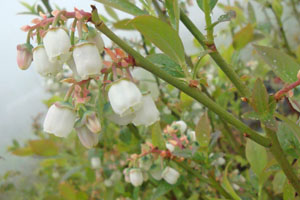Developing a British Blueberry Industry
Published on 18 July 2011 in Food, health and wellbeing
There is an un-met demand for UK grown blueberries (only 1-3% of requirement met) as currently growers cannot provide the right material for the market place. Soft fruit growers have the infrastructure and skills to move into blueberry, a high value crop and with climatic variation in the UK can supply the market from June to October and possibly beyond with appropriate varieties. There is great potential for UK growers to supply high quality, fresh blueberries across a wide season so that consumption of this fruit can be integrated in the Scottish and British diet.

Key Challenges
Currently 80% of consumers do not purchase blueberries and with appropriate varieties and cost structure this could be changed. Cultivar knowledge needs to be developed for the UK which defines varieties of the appropriate quality in terms of establishment, growth characteristics, cropping season, fruit size, flavour, health components and machine harvestability and resistance to major diseases. Leading varieties imported from elsewhere have often been shown not to be suitable for the UK season.
Key Benefits
Fruit consumption in the UK, particularly of berry fruits, is expanding rapidly. In 2009, sales of soft fruit increased by 17.2% in the UK with a combined retail sales value for strawberries, raspberries, blueberries and blackberries close to £700 million. Consumer demand for blueberries (Vaccinium spp.) is at record levels, partly due to their perceived health benefits but also their convenience and enjoyable flavour. Blueberries account for 17% of fruit sales but it is estimated that only 3% of the blueberries purchased in the UK are grown here. Imports, primarily from Argentina, Chile, Spain and Poland supply the significant shortfall. However, this is beginning to change with growers across the whole of the UK from the south of England to the north of Scotland beginning to produce blueberries. It is anticipated that the combination of this geographic spread, together with the temperate climate, will allow marketing of UK-grown blueberries from June through to late October.
“This James Hutton Institute project represents the first systematic study of the combined impact of genetics and environment on fruit phytochemistry in relation to the sensory and potential health properties of the blueberry.”
UK growers are currently planting mixtures of existing varieties, mainly from the USA, but the long term performance, fruit quality and consumer acceptance of these varieties in the UK is largely unknown. It is known that environmental cues significantly affect the performance of different blueberry varieties and informed variety selection is a key component for success.
A genetic framework for future crop improvement is required to develop a thriving and sustainable industry. The genetic component of this project builds on the statistical developments derived from the software programme, TetraploidMap, to identify fruit quality, health and agronomic related quantitative trait loci (QTL) in tetraploid blueberry for marker assisted breeding.
Knowledge of cultivars and establishment will allow the UK industry to be based on the best germplasm for the growing conditions and requirements. This project based at JHI represents the first systematic study of the combined impact of genetics and environment on fruit phytochemistry in relation to the sensory and potential health properties of blueberry fruit. By linking the phenotype to genotype a genetic framework for future crop improvement using marker assisted breeding will be established and this should greatly increase the speed and precision of blueberry breeding.


Comments or Questions
Related Websites
Our Partners
HortLINK and soft fruit industry
Find Out More
For more information contact Susan McCallum (Susan.McCallum@hutton.ac.uk) or Julie Graham (Julie.Graham@hutton.ac.uk)Author
Susan McCallum Susan.McCallum@hutton.ac.uk







